|
Why We Rescue
The open rescue movement exploded in 2015, then stalled in 2018. Here’s how we are reigniting it.
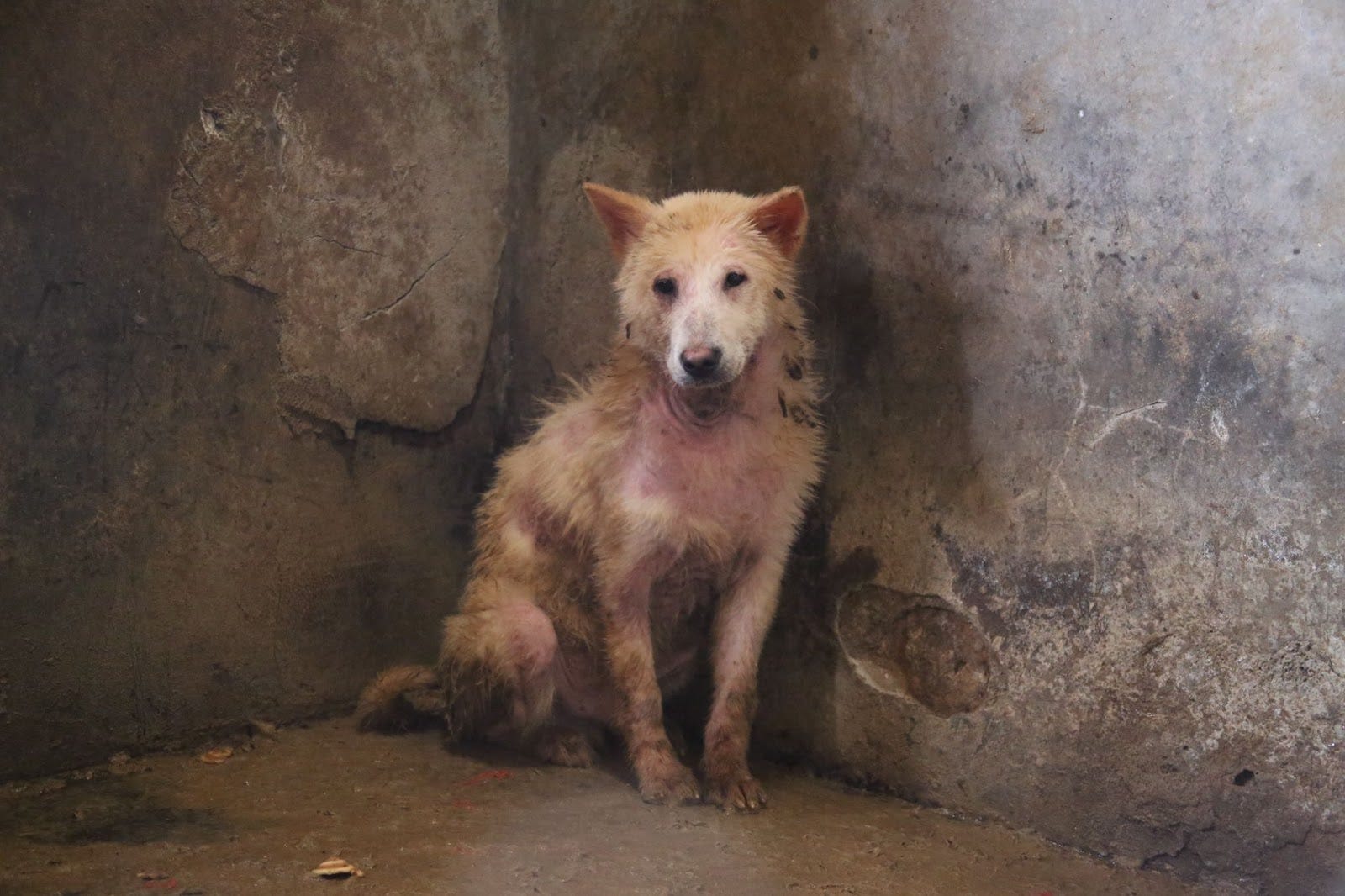 |
Two moments in my life changed everything, and taught me important lessons about changing the world.
The first was when, as a child, I saw a dog being beaten to death for the first time. Her huddling, defeated posture and terrified eyes showed me a shadow hanging over human civilization: the violent extermination of animals across the globe. Tears poured from my eyes as I heard the dog’s piercing death cry.
The second was when, as an adult, I walked into a slaughterhouse for the first time. I saw the same huddling, defeated posture and terror in a lamb’s eyes, as she whimpered in the face of impending doom. But this time, I did not cry. I plunged into the darkness of the abattoir and tried to save her.
Check out the first episode, Why We Rescue, of our new YouTube channel!
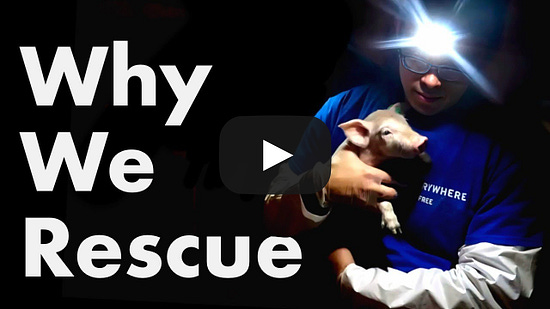
And, though I failed – the lamb was 120+ pounds and too frantic for me to rescue on my own – I succeeded at something else. I realized it was shockingly easy to enter a slaughterhouse and, if I had help, to save not just one but many lives. In that moment, as I scrambled through blood-stained livestock pens, I glimpsed something bright in the shadow of violence: a world where a crying dog and lamb are met with a gentle touch, rather than a slaughter man’s blade. It was a vision of open rescue – one so powerful that it changed my life.
For most of the last 20 years, I have been learning more about this power and sharing what I’ve learned. I have personally carried dozens of animals from fortress-like factory farms and dystopian laboratories; I have trained and organized others in rescuing hundreds more. And in doing so, we healed the world, in big ways and small. Broken systems like the fur trade, which had dominated North America for 500 years, were abolished by harnessing the stories of rescue. Broken creatures such as Mei, a little bird whom we carried from darkness and dust into the sunlight of a free world, had their lives transformed. In a world of disinformation and distrust, open rescue’s power stems from the fact that it is honest, loving, and real. It is animal liberation brought to life.
Harnessing this power, the open rescue movement exploded from 2015-2018. In 2017 alone, teams I led executed a dozen nationally-significant open rescues, including successful missions at the largest pig farm in the nation, a prominent free-range turkey farm, a massive beagle production facility, and the first daylight open rescues in US animal rights history at slaughterhouses in San Francisco and Oakland.
Many other organizations, such as Meat the Victims and the Save Movement, pushed forward with rescues of their own. Open rescuers such as Leah Doellinger in Australia made international news.
But something changed beginning in 2018. The open rescue movement slowed and, in recent years, has nearly come to a halt. I am aware of zero notable open rescues in the United States so far in 2024, and only a handful in 2023. Other than an inspiring surge in direct action led by Animal Rising in the UK, including a dramatic rescue of three lambs from King Charles last August (yes, that King Charles!), the global movement for open rescue seems to have stalled.
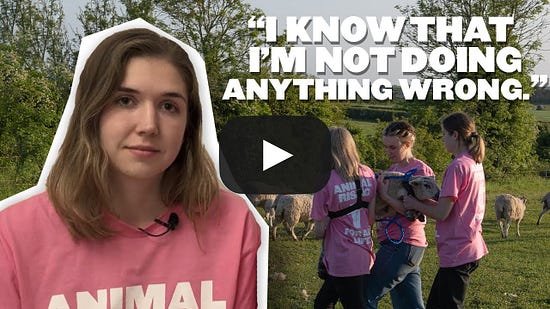
The most obvious reason for this slowdown – legal repression – is not a satisfactory explanation.¹ After all, just weeks after serious felony charges were filed in Utah, five hundred people joined us in a mass open rescue at Sunrise Farms in May 2018. Legal repression has, if anything, brought even greater attention and support to the cause of open rescue. But then what caused the rescue movement to stall?
There are three interlocking problems, all self-inflicted injuries, more important than legal repression: organizational focus, infighting, and vision.
Organizational focus. Difficult goals require exceptional focus. Steve Jobs of Apple was famous for asking his top 100 executives to pare down the company’s most important goals, leading to a list of the top 10 priorities on a white board at the company’s annual strategy meeting. He would then cross out the bottom 7 priorities and say, “We can only do 3.” This ruthless focus allowed the company to repeatedly change the world.
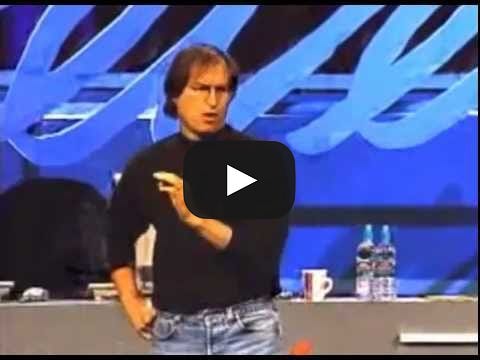
One of my failures as a leader was allowing organizational focus to drift starting in 2018. When we launched Direct Action Everywhere (DxE) in 2013, open rescue was my north star. But five years in, as lead organizer of DxE, I jumped from rescues to legislative campaigns to coalition efforts that lacked a coherent long-term strategy. All of these projects seemed like important opportunities, but they distracted me and the movement I led from the open rescue engine which had experienced exponential growth from 2015-2018.
Infighting. When I asked the renowned Stanford sociologist Doug McAdam for advice in 2016, he warned us about one pitfall above all others in building movements for change: infighting. As Doug explained, internal conflicts (often driven by disputes over racism, sexism, and other forms of so-called “identity politics”) end up “blowing off people’s arms.” The solution to this problem was to create private dispute resolution processes; insist on their use; and, above all, avoid the circular firing squad of activists calling each other out.
When we launched DxE in 2013, we had a strong set of external values, including nonviolence, that guided how we interacted with the public at large. But we did not give sufficient attention to internal values that would guide how we would interact with each other. It took years before we adopted the norm that our activists should call people in, not out. Worse yet, we did a terrible job of enforcing the norm against call outs even after adopting that norm in 2015. In 2017, I stood by and allowed organizers to continue within DxE, even as they publicly attacked their fellow organizers with sexual misconduct allegations that were, in many cases, demonstrably false. This was precisely the problem Doug identified in 2016 — infighting driven by identity politics — and it undermined our ability to build cooperation and scale up the movement for rescue.
Vision. Big change requires big dreams. When Martin Luther King, Jr. prepared his “I Have a Dream” speech at the March on Washington in 1963, he was unsure of what to say, even in the minutes leading up to his speech. He had prepared a written set of remarks but, as he started to talk and noticed the crowd’s lukewarm response, he began skipping entire paragraphs. Then suddenly, in the middle of his speech, someone shouted from the crowd, “Tell 'em about the dream, Martin!" And that’s what he did. King put down his notes and spoke of a dream: a world where descendants of slaveholders and descendants of slaves would ”sit down together at the table of brotherhood.” It was an absurdly ambitious vision. But just one year later, King’s dream took a huge step forward in the Civil Rights Act of 1964.
Perhaps my greatest strength as an organizer was my ability to set out an ambitious vision for the movement. In blogs, talks, and videos, I spoke about achieving animal liberation in one generation, triggered by a movement of thousands openly rescuing animals from violence. Internal surveys of DxE activists showed that this vision was the #1 reason they were involved.
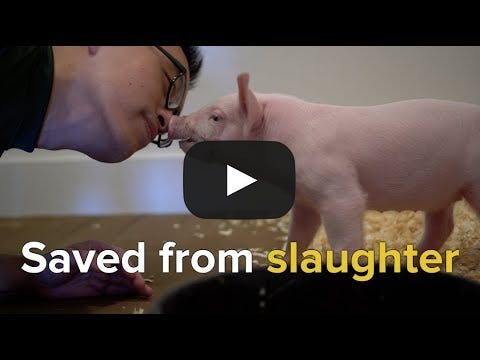
But my strength became a weakness in 2018, when a combination of organizational responsibilities and infighting led me and other leaders to mostly stop our work on vision-setting. I stopped writing and giving speeches about liberation in one generation. I was too tired – and, increasingly, too cynical – to defend the dream.
Perhaps most importantly, I stopped living the dream myself. Starting in 2018, I ended my direct involvement with open rescue. This was a mistake. It took a conservative jury in Utah, who acquitted me after I was charged for openly rescuing two piglets from Smithfield, to remind me why. Open rescue did not just win freedom for two piglets; it offered a roadmap for freeing them all.
So how do we solve these three problems? The last problem – the lack of vision – also provides the solution. To reignite the movement for rescue, we need to reignite the vision. This Substack newsletter (which has received extensive editorial guidance from Tonia Moore, among many others) and the YouTube channel we’re launching today (a joint project between me, Jeremy Loeb, Joseph Allman, and Chloe Leffakis), are our first steps in doing that. These platforms will be focused on our dream: a world where thousands rise up to openly rescue animals from abuse.
But the vision goes far beyond a single communications platform. We need an entire ecosystem of storytelling — videos, blogs, and (above all) in person meetups — that inspires people to engage with rescue in the real world. For that reason, you’ll see us organizing trainings and events around the content we create, and supporting other influencers involved in nonviolent direct action – people like David Ramms, PETA’s Jamie Logan, Animal Rising’s Dan Kidby, and the many leaders at DxE – in doing the same. Through these interlocking connections and communities, built on a collaborative culture and sustained by a relentless organizational focus, we will build a movement of thousands to openly rescue animals from abuse. And, through the power of that movement, achieve constitutional rights for animals in one generation.
The two moments in my life – one a nightmare, the other, a dream – showed me the power of this vision. There are shadows in this world darker than what most people can imagine. But if we see the power we hold, collectively, we can cast out those shadows with the power of light.
I hope you’ll join us on May 26 as we discuss our strategy for doing that.
—
What’s up this week
I’m at the Animal and Vegan Advocacy (AVA) Summit in Washington, DC this week and would love to connect! And there are some changes to the schedule. The conference has added an Activist Defense Meetup on Thursday, May 16 at 9 am. This is in addition to the talk I’ll be giving about the roadmap to constitutional rights on Saturday, May 18 at 2pm. But I’m also very interested in hanging out with folks in an unstructured way at the conference — and maybe even taking a field trip to Sticky Fingers! (Joe, Mirais, and Matthew from The Simple Heart team will also be at AVA.) If you’re interested in hearing more about those informal hangouts, regardless of whether you’re formally registered for AVA, let us know here. (I should also add that, while I’m not allowed to attend due to the conditions of my conviction in Sonoma County, DxE lead organizer Almira Tanner is organizing a Direct Action Meetup on Thursday, May 16 at 3:30 pm. Don’t miss it! )
There have been some fascinating and powerful stories about protest and animals in the media in the last week, including two stories in The Atlantic. The first, The Cat Who Saved Me, is a touching portrait of a depressed man who is saved by his feline friend. It was the most popular article on the magazine’s site for a few days and brought tears to my eyes. The second, The Problem With America’s Protest Feedback Loop, reviews the social scientific research on protest, including the failure to maintain nonviolence or develop real organizing capacity, and points to a more fundamental problem: Americans’ profound distrust in existing institutions. Both articles are well worth the read.
Belgium just enshrined animal welfare in its national constitution. This is a major victory and a sign of the shifting attitudes towards animals. While this is not the same as personhood as rights, it’s one of the many signs that animal rights — like gay rights 20 years ago — is on the cusp of a breakthrough.
As noted above, we’re launching a new YouTube channel focused on rescue, with episodes coming out on Tuesday and Friday. We’ll have conversations with guests who have been part of the most dramatic rescues in history, like DxE co-founder Ronnie Rose. But we’ll also speak to others who can help us understand how we can build an entire world where rescue, rather than slaughter, has become the norm. I’m very interested in feedback on the show, so please leave a comment or send me a note. And we’ll simultaneously be releasing these episodes as podcasts on a relaunched Simple Heart podcast, so be sure to check us out on whatever app you use for podcasts.
That’s all for the week!
I do not mean to suggest that legal repression is not a serious deterrent but, rather, that there are always activists able and willing to bear the risk of that repression, including both before and after 2018.
Thank you for reading The Simple Heart! To help us reach more people, become a donor today.